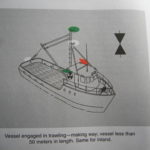
What Are Day Shapes?
Day Shapes are an important tool for marine navigation. But before we can discuss their function we must first review the basics. We all should know about red and green buoys, day markers, day beacons and ATONs (Aids To Navigation). These aids help the boater safely navigate their course. Navigation lights are found on a vessel and are also called running lights. These navigation lights are also red and green with the occasional white or yellow lights. These lights indicate the vessel’s position, heading and status. Got all that? If not, we will point you in the right direction a bit later in this article.
But what do you see in daylight when you cannot see the lights or colors? Simple answer: you see day shapes. Shapes are used in daylight to communicate vessel status. In the day time you can’t easily see a vessels lights so these shapes are another important tool to understand what other boats are doing both on inland and off shore waters. These shapes are black in color and vary in size depending upon the length of the vessel. And, you want other boaters to see your shapes so they know your status.
What Do Day Shapes Look Like?
The primary day shapes are a ball, a cylinder, a cone and a diamond. Sometimes day shapes are used alone and sometimes two or more shapes are joined. Two cones with points facing each other denotes a vessel trawling for fish or shrimp. A round black ball indicates a vessel at anchor. And yes. We should all display the anchor day shape when our anchor light is not illuminated in the day time.
ATONs use shapes to denote red or green. When the sun is in your eyes you can tell a red from a green day marker. So, a boater displaying a black ball day shape allows you to understand that he is not underway, but at anchor. Be sure to scroll down and see the photos with captions and even a video so you will appreciate real world day shapes.
Rules of the Road Resource
And yes, there is a book for that. If your boat is greater than 12 meters, 39.4 feet USCG Federal Law requires you to have a Navigation Book aboard. This is the more common book we see and it is often referred to as The White Book. See the last photo for our well worn copy. It’s a good reference for many navigation tips including day shapes.
Next time you see a shrimp trawler don’t just assume it is fishing. Check for the day shape in day time or lights at night. And what about a dredge? What side is it safe for you to go around. The answer is in The White Book.
Get one and use it for a quick reference as it is intended and required by law. Ask Captain Chris 772-205-1859 or join us for a Cruising FUNdamentals seminar.
And if you can’t attend a seminar in person and you’d like to learn more about the fundamentals of Navigation or have a crew member who needs to brush up on these skills, check out our video Navigation Made Easy to rent or buy $9.99 or $14.99.










